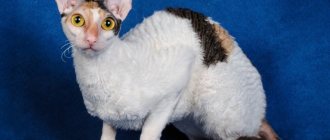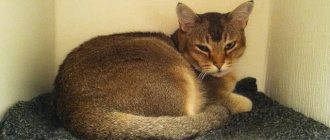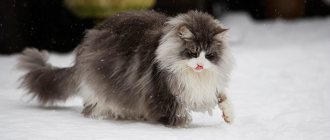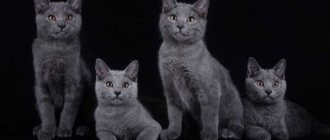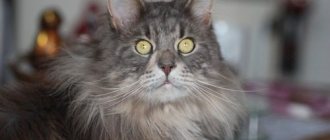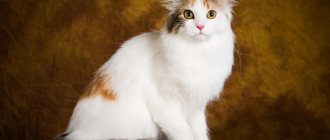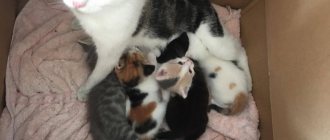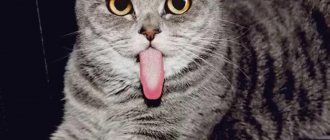Man's desire to show his strength and power was reflected in the domestication of wild animals. Of course, domesticating serious predators like a cheetah or a tiger is an initially unpromising and downright dangerous idea, but it turned out to be quite possible to “deceive” nature with the help of genetics. Let's see what came out of this using the example of cat selection. Here are the names and photographs of rocks that were the result of scientific experiments. And I must say, very interesting and successful.
Savannah
One of the wildest and most exotic cat breeds, in which the blood of the temperamental and freedom-loving African serval flows. The official date of appearance of the standard is considered to be 1986, but Savannah received its official recognition only in 2001. Externally, the cat looks very striking and thoroughbred due to its characteristic color and noble posture. She is energetic, cunning, agile and has remarkable intelligence. It is endowed with amazing jumping ability, and its habits are similar to its distant relative - the cheetah. Adults can reach a weight of up to 14 kg. In terms of intelligence and intelligence, it is more reminiscent of a dog than a cat. He gets along well with a leash, loves to swim and is quite easy to train.
Photo gallery: rusty cat
Wild spotted cat stays awake at night
Rusty cat eats small rodents
Rusty cats in captivity do not sleep during the day
The little kitten looks very cute
The rusty cat has very big eyes
Rusty cats are great at climbing trees
Rusty cats live in rocky areas
During the day, rusty cats usually hide in secluded places and sleep
In the Berlin Zoo, kittens were born to a rusty cat for the first time
Cats wait for their prey, sitting in ambush
Safari
A rare breed bred in America in the 70s of the last century. The result of crossing a wild Geoffroy cat and a simple domestic cat. They have powerful muscles and a large skeleton. In adulthood they can reach a weight of 13 kg. The coat is short, soft, dense in structure.
Traditionally they have a spotted brindle color of a golden-brown hue, but sometimes there are animals with a silver tint to their coat. Safaris have a violent temperament, which makes them tireless in active games. Like all representatives of wildlife, they are wonderful hunters and will never miss a moment to practice their skills on birds, rodents and other small “prey”. Despite their independent character, they quickly become attached to their owners and get along well with children.
Forest cats, varieties (19 photos)
Author: Yugansk
27 January 2021 20:22
Tags: Forest cats Photographs. animals interesting nature
4847
19
We are all somehow accustomed to an ordinary cat, living next to a person for centuries. Everyone knows the familiar pet purring near a saucer of milk. But not their wild counterparts living in the forests of Eurasia and the African continent. There are several representatives of the wild cat species.
1.
0
See all photos in the gallery
Forest cats are usually slightly larger than domestic cats and are well adapted to life in the wild. Having met a handsome wild animal in the forest, you should not think that it is Vaska who has gotten lost, but let the animal go its own way.
2.
0
Decent size is the main difference between the European forest cat and once domesticated species. The length of the body can reach 80 centimeters, the weight of individual individuals, depending on the species, starts from 3 kilograms and ends at 11. The tails are also different: their length is up to 30 centimeters, “chopped off” by nature, it is quite thick and very fluffy. The longest hairs grow at the tip of the blunt tail. The paws are also larger, and the sharp claws are retracted into the “sheath” when walking. In winter, wild cats sport a thick dark coat, but by summer they change it to a lighter coat. Forest cats are usually heavily decorated with dark stripes. Their large ears are devoid of tassels, and their eyes mysteriously glow with yellow-green lights. Widely spaced ears provide the animal with excellent hearing, and the eyes are able to discern a small rodent rustling in the forest floor. Forest predators have stereoscopic vision; scientists say that these cats distinguish colors.
3.
0
Whiskers, called vibrissae, are not only an ornament to a cat's face, but also a sharp sensory organ. Subtle natural sensors will tell the cat about prey approaching at a distance favorable for hunting, and will help in “calculations” about the possibility of movement in narrow places. The inhabitants of the African continent are inferior to their Eurasian counterparts in size and weight, but their skins are painted in lighter shades.
4.
0
Norwegian Forest Cat The Norwegian Forest Cat is a fluffy beauty from Scandinavian myths. Legends describe a predator with the name “Forest Cat”, capable of running along steep cliffs. Similar Norwegian cats carried the beautiful goddess Freya in harness. In our time, the king took the beautiful animal under his personal protection, granting him the status of a national cat. For centuries, the Norwegian forest cat lived next to people, some individuals served as mousecatchers on merchant ships. This type of forest cat was even exhibited at the International Cat Show in Germany in the last century. Recognition of the Norwegian Forest Cat as a separate breed saved the subspecies from extinction. Cats were brought to Russia, and through human efforts they reached the United States. Professional breeders started breeding the breed. It has been proven that this is a Norwegian cat - the closest relative of the May Coon.
5.
0
The Norwegian forest cat is the largest subspecies, reaching a mass of ten kilograms. Strong paws allow them to run head down from almost vertical surfaces. But as your pet ages, joint problems appear. The Norwegian forest cat living in the north is better insulated than other subspecies. There is thick fluffy fur and abundant undercoat. The ears and spaces between the fingers are covered with a warming layer.
6.
0
Caucasian forest cat The Caucasian forest cat is a subspecies protected by the Red Book; it was hunted too much in the last century. Lives in the highlands of the Caucasus and Turkey. They live alone, hunt small rodents and birds, but can feast on a hare or a weakened roe deer. Typically, the Caucasian forest cat is gray in color with pronounced dark stripes, but there are also black specimens. This subspecies of the forest cat has changed the least; it does not interbreed with domestic cats. The subspecies is distinguished by its large size; the male Caucasian forest cat often reaches ten kilograms. By winter it acquires insulated fur, which allows it to hunt in mountain winter conditions.
7.
0
In Dagestan, cats have taken a liking to the river banks; the inhabitants of Georgia often go down to the sea beaches. And in the area of Batumi and Poti, the Caucasian forest cat lives in the “wet” conditions, hunting every day in rivers and walking on wet dirty grass. The local forest cats even swim in streams when hunting for fish.
8.
0
Far Eastern forest cat The Far Eastern forest cat “disguises” itself as a small tawny leopard. His light coat is evenly covered with red “leopard” spots.” This is a skilled nocturnal predator that lives in hard-to-reach places. The Far Eastern forest cat is a close relative of the Amur forest cat; sometimes they, descendants of the Bengal cat, are combined into one subspecies. The Amur forest cat is distinguished by three dark stripes stretching along its back and light sides. The body is strewn with coin spots, for which the Chinese nicknamed this subspecies “money cat.”
9.
0
Amur forest cat The Amur forest cat has inhabited the forest expanses of the Far East, its habitat extends to the Amur, the coast of the Sea of Japan, reaches Hindustan, the Malay Archipelago. Many forest cats of this subspecies live in the lands of China. Leads a nomadic lifestyle, swims remarkably well, and sometimes lives in pairs. In cold weather, predators move to lowlands not blown by the wind to escape drifts near human habitation. This forest cat gets used to humans better than others; it can be kept in an enclosure, away from strangers. The European wild cat is the most similar to the domestic cat. The same gray skin and stripes, only the fur is tall and thick. Lives in the Caucasus regions, in low mountains, in the forests of Ukraine, in European countries. Selects an area with dense forest.
10.
0
Habitats The forest cat has more than twenty subspecies living in European countries, on the territory of the Russian Federation, and is found in the Middle and Far East. The cat population lives in the forests of Ukraine, Moldova, Lithuania, the Caucasus, Norway, and some species have chosen the expanses of Scotland.
11.
0
The main habitat is beech and hornbeam forests; it can live in floodplains. Prefers lands with a temperate climate, although winter wool provides good warmth in the frosty months. Sometimes it settles on the banks of rivers and seas. Sometimes cats make a safe lair on miniature islands. But the wild cat does not like regions characterized by heavy snow drifts. You won’t find it in places with extremely low winter temperatures. If there are prolonged snowfalls that cover the forest, then free animals migrate closer to human habitation.
12.
0
However, the twentieth century significantly reduced the species number and population size of European forest cats. These animals have taken a place in the Red Books of Belarus, Moldova, and the Russian Federation. The reason was the reduction of forests, cold weather, and traps set by hunters. Sixty years ago in the North Caucasus, industrial production of animals was carried out, shot for their fur. The subspecies that lived in Dagestan have almost disappeared, due to cold winters and a reduction in the number of rodents. Now the population of the local species is being restored in the Teberdinsky and Caucasian nature reserves. Representatives of the species that lived en masse in Polesie (Ukraine) have almost disappeared, but a decent number of cats live in the highlands of the Carpathians and in the Danube floodplain.
13.
0
Lifestyle and habits The forest cat is a sybarite of the wild, preferring to hunt in the most comfortable conditions. It goes out for food in the evening or pre-dawn twilight, when the sun is about to set or rise, and the forest falls asleep or peacefully dozes before the morning awakening. The cat will not leave his shelter if it is too cold outside, it is raining or it is simply slushy and unpleasant. He will wait out the bad weather in comfort, and will go for prey when the weather clears up in the forest. The cat is the sole owner of his hunting grounds; he carefully marks the entire territory (a couple of hectares of floodplains or 60 hectares of forest), informing his brothers about the occupancy of the area. It makes regular rounds of the land, walking up to ten kilometers a day, but moves far from the borders only during the mating season. Housing for a forest cat can be a hollow, a crevice in the rocks, or a hole left by the previous occupant. The predator often changes its roosting location, choosing the most abundant food supply. In summer, animals are driven away from their favorite corner by fleas; in winter, they often change their location due to problems with hunting in conditions of high snow cover.
14.
0
Hunts with sharp jumps, instantly grabbing the prey. Excellent vision and hearing, plus signals picked up by the vibrissae, help them hunt in poor lighting, but wild cats have difficulty discerning odors. It can wait for prey near the lair or in “fishy” places. They never stock up, preferring to dine on freshly caught prey. Cats living near ponds hunt from branches overhanging the water and hide in the reeds. From such an ambush, a predator can even overtake a waterfowl. Fortunately, he knows how to swim, although he really doesn’t like getting his fluffy fur wet. He overtakes rodents running freely in trees by quickly climbing the trunk and running across the branches. In the excitement of the chase, in a dense forest, it can even jump from tree to tree. It grabs small animals with its paws, holds it tightly and bites the back of the skull with sharp teeth. The prey, which is superior in mass, tries to “mount” it and inflict a fatal wound in the neck area. The character of a wild cat is radically different from the usual cute cats. These are proud, aggressive loners, accustomed to surviving in the wild. They do not allow people to approach and do not invade the boundaries of settlements unless absolutely necessary. By nature, these cats are silent. But an aggressive attack will be accompanied by a dissatisfied hiss and howl, and courtship play will be accompanied by an inviting meow.
15.
0
Sometimes they try to place a forest cat at home, making it a cute pet. You can try to house a predator like an exotic toy in the enclosure of a country mansion, but it will simply destroy the apartment. Plus, we must take into account that this is a nocturnal resident, marking its territory. In captivity, it will live a long time (up to 30 years), especially if the usual diet is provided. But he won’t become a fluffy, loving ball. Individuals taken as kittens partially lose their natural talents as hunters. But people are still distrustful. He will get used to the family (having first tried to take the main place in the house), but he absolutely cannot stand strangers. He will also not tolerate other representatives of the fauna near him; domestic cats will become his first rivals.
16.
0
Diet In terms of food, the forest cat is also a gourmet and a glutton: he prefers to eat fresh prey; his daily diet can consist of a dozen small rodents. An adult can consume up to a kilogram of food daily. The victims of cats are: voles dormouse partridges pheasants coots gray rats muskrats trout nutria rabbits moles squirrels shrews weasels martens lizards Once upon a time, cats living in the steppe regions caught bustards and even eagles; sometimes a large individual can defeat a small roe deer. Predators living on the banks of rivers and the inhabitants of floodplains hunt for fish and aquatic animals. When approaching human habitation, cats free the surrounding area from the rodents that have settled there. While helping people in this way, they are doing harm at the same time by eating poultry. They cause harm to wildlife by destroying rare birds in protected areas (for example, in the Caucasus).
17.
0
The meal process resembles that of an ordinary cat, but the front paws do not fall to the ground. It chews its prey, biting off one piece at a time, starting from the side of the carcass.
18.
0
Reproduction In this regard, the forest cat can be safely called a March cat. This month marks the height of the mating season for the feline inhabitants of the forest. Only during this period do cats move away from carefully marked personal areas in search of a mate. A couple is sought for one season; a potential partner is attracted by screams and meows. After parting, the male returns to his lands and is not at all interested in the offspring. The expectant mother looks for a secluded place and prepares for childbirth, lining it with the gifts of the forest. The female gives birth two months after communicating with the cat. Usually this is the end of April or the beginning of May. A litter can have from two to seven kittens, with three or four kittens being the norm. Blind and deaf helpless lumps need maternal care (the eyes open from the ninth to the twelfth day). The female takes care of the kittens for a whole month, not being able to move far from the den. Babies drink milk for four whole months, but after the first month they are already trying to look out of the house in order to begin exploring the world. The most curious and careless kittens often get caught in the teeth of martens and birds of prey.
19.
0
Babies get rid of their baby teeth between the fifth and eighth months of life. In the second month of life, the mother begins to teach the important science of survival. Teaches how to hunt. And they become sexually mature before they are one year old. The forest cat is a beautiful and graceful predator. Accustomed to living in splendid isolation in the wilderness, high in the mountains or on the banks of rivers. He does not like people, approaching housing only during the difficult months of complete lack of food. For relaxation and reproduction of offspring, he chooses a ready-made living space, slightly arranging it. Depending on its habitat, it has a varied diet: from trout to roe deer. It deftly attacks prey, lies in wait for rodents, and runs along branches after squirrels. The beautiful animal occasionally finds itself in the role of a pet, but it copes with this mission very poorly, its instincts and habit of a twilight lifestyle take its toll. Coupled with a bad disposition, they make him not the friendliest animal. So it is better to leave it alone in its natural habitat. An exception can be considered the Norwegian forest cat, raised by breeders, and the well-tamed Amur forest cat.
Source:
Related links:
- Lemming Facts - An Unexplained Tragedy
- 6 interesting facts from the life of the connecting rod bear
- 7 interesting facts from the life of the polar fox
- How a mongoose creates a mud vest against snake bites
- 6 interesting facts about the primate with the unusual nose
Tags: Forest cats Photographs. animals interesting nature
Did you like the post? Support Chips, click:
156 5 151
Liked
151 3
8
Partner news
Serengeti
African grace and beauty - this is how this big wild cat can be described. The name of the breed in translation means “endless valley”, which in principle reflects the entire essence of the animal’s character: willfulness, pride and natural originality. It is interesting that the Serengeti was originally conceived as a similarity to the serval, but in practice its “progenitors” were the Bengal, Abyssinian and Oriental shorthair cats. The breed began its life in the 90s of the last century and today is the rarest in the world. There are only a few hundred of its representatives, and the number of official breeders does not exceed ten people. The cat is very graceful, curious and has obvious leadership qualities. Fearless, but at the same time unusually talkative and literally follows on the heels of her master.
Is it possible to tame
Despite the fact that the Rusty Cat is listed in the International Red Book, the number of the species is still declining. This contributes not only to the direct destruction of animals by humans, but also to the global decline in habitats suitable for the species and the deforestation of tropical forests.
It has been established that at the moment the number of adult individuals on the planet does not exceed 10 thousand.
The local population of Sri Lanka and India have repeatedly made attempts to accustom the predator and make it a pet. Sometimes this was successful, since the animal is unusually inquisitive.
If small Rusty Cat kittens come into a person’s home, they are successfully socialized and grow up to be playful, self-sufficient, energetic animals with a light and cheerful disposition.
It will not be possible to purchase a pet and take it to another country; all sales of animals listed in the Red Book are prohibited.
Some specimens of the Rusty Cat are kept in the largest zoos in Europe, America, and Asia, but in captivity the breeding of the pet practically does not occur.
The appearance in 2021 of the Rusty Cat cub in one of the most outstanding zoos in the world in terms of the quality of animal care and beauty of the world—Berlin Zoo—immediately became a real sensation. This is the first recorded case in 168 years of a kitten of this species appearing in captivity.
Siberian
The breed acquired its current appearance both through the efforts of breeders and natural evolution, which modified the cat in natural conditions. She is equally suited to both statuses - wild and domestic. The first standard was announced in 1988. The distinctive features of the animal are a large, developed body with powerful paws, as well as long, hard and thick hair with water-repellent impregnation. To bathe such a fluffy ball, you need to try hard. The color of the “Siberian” can be different: from silver-ash to peach and red with tan. In Russia there are a lot of different color names, photos of which can be easily found on the Internet. Cats are very affectionate, friendly and have a sharp mind. They love to roam free, happily hunting birds and mice.
Chausi (chausie)
One of the most expensive breeds in the world, officially recognized only in 2003. It is considered a hybrid, bred by crossing the Bengal, Savannah, Abyssinian and ordinary domestic cats. The result was an animal with a domestic character, but inside retaining the temperament of a savage. It is very difficult to breed and is practically not found in the post-Soviet space. Many features of the Chausi have been preserved from her distant ancestors: long strong legs, proud and graceful posture, high cheekbones and large ears that catch the slightest shades of sounds. Cats are active, inquisitive, love heights and are ready to jump on the mezzanines of closets and the backs of sofas for hours. They do not tolerate loneliness well, missing everyone in the household.
Cheeto
A real Tarzan cat, inherited from its descendants a courageous disposition and domestic obedience. The breed appeared as a result of crossing a Bengal cat and an Ocicat. The external resemblance to cheetahs is no coincidence, although many generations separate it from its wild relatives. Despite their fearless nature, such cats do not live independently in nature, although their behavior is very willful and energetic. Chitos are smart, devoted to their owners, willingly allow themselves to be petted, and are distinguished by their enviable obedience. A distinctive feature of this breed is that the males show tender care for the kittens - a rather rare phenomenon in the cat “world”.
Pixie bob
The breed was registered in 1995, although trial crossings were carried out long before official recognition by TICA. The cat's name translates as "elf with a short tail." In addition to the chopped off tail, the uniqueness of the animal is given by the mischievous tassels on the ears, making it look like a wild lynx. Because of the lowered eyebrows, the muzzle seems somewhat gloomy and gloomy, although in fact the cat has a cheerful, kind and inquisitive character. She is very tactful and self-possessed, easily gets used to a leash, loves to talk and play active games. For all its openness, the pixie-bob is wary of strangers, but this quality is inherent in them, rather from a jealous attitude towards the owner than from distrust or suspicion.
Reproduction and care of offspring
Steppe cats prefer to lead a solitary lifestyle . Each male has his own territory, which he jealously guards from the invasion of other cats. The females also help guard the territory, settling not far from the males, and, if necessary, join their efforts to drive away the strangers.
The mating season for these animals lasts from January to March. Interestingly, unlike domestic cats, steppe cats are rather quiet creatures and try not to attract attention by screaming and meowing. Only during the mating season, these cats can make different sounds, from loud meows to snorting and growling.
A female ready for mating can be courted by several males, and she chooses the largest and healthiest male as the father for future offspring. After courtship and mating, the male leaves the female and does not take any part in raising future offspring.
The pregnancy of a steppe cat lasts from two to two and a half months. As a nest, the female builds a hole or hollow in a tree. Young females give birth to one or two babies, while more mature individuals have up to six kittens in a litter. But most often, steppe cats give birth to no more than three babies. Kittens are born blind and helpless, and for the first six months they are completely dependent on the care of their mother.
Steppe cats have a highly developed maternal instinct, and they never abandon their offspring. Two weeks after birth, the kittens' eyes open, and a month later, the babies are already covered with fur and look like a smaller copy of their parents.
The female feeds the cubs with milk for more than two months, and only after this period has passed does she begin to accustom the kittens to adult food. First, the steppe cat brings the kids small rodents caught during the hunt. As the kittens grow older, the female brings live prey to her “nest,” teaching the cubs to hunt on their own.
For two to three months, steppe cat kittens do not leave the parental den; after this period, the cubs begin to go hunting with their mother. The steppe cat takes care of its babies for six to seven months, then the matured kittens begin an independent life. Sexual maturity of steppe cats occurs a year after birth, but usually, males are ready to breed only at the age of two.
Bombay
A domestic mini-panther is the first thing you want to say when you see this cat. Work on developing the breed began in the USA back in 1956, and only after 20 years of painstaking breeding experiments did it receive the long-awaited standard. The result of crossing the Burmese and the American Shorthair cat was the beautiful Bombay - perfectly black, orange-eyed and incredibly graceful in her posture. The cat's fur is so smooth and shiny that it feels as if it has been treated with a special mastic. Animals of this breed are very affectionate, sociable and active. They also have a high sense of self-esteem, not tolerating unnecessary liberties with themselves, especially from children.
Bengal
The result of crossing an Asian leopard cat and a short-haired domestic cat. The ancestors of this breed continue to lead a wild lifestyle, but their “heirs” are perfectly domesticated and, perhaps, have retained only their unusual color and flexible powerful body from the old days. The fur of the Bengal cat deserves true admiration - smooth, shiny, dense texture and characteristic coloring in the form of spotted tans of a golden-orange hue. This mini-leopard has a tolerant character, which allows him to get along even with dogs. Due to its genetics, the animal loves to climb trees, is not afraid of water and has an instant reaction.
Mr. Cat recommends: habits
Its miniature size allows the spotted red cat to be an excellent and inconspicuous hunter, but this also makes it vulnerable to large predators. Therefore, the main key to the success of the animal’s survival is the swiftness of its movements. It is also very difficult to catch because its low weight allows it to easily climb onto thin tree branches. The big cat species can't resist them.
The lifestyle of the Rusty Cat is the same as that of the Bengal. These are solitary animals. They prefer to live and hunt close to the forest, so that at the first sign of danger they can climb to a saving height.
This predator can also swim well. If there is a river near the cat’s lair, then they are excellent at fishing.
Each animal has its own habitat, occupying about 15 square meters. km.
The cat “walks” with the male only during the stormy rutting period. Then he leaves it to find a safe den and carry out the kittens. This period takes 2-2.5 months. The burrow is usually located between the roots of trees and is so narrow and small that another predator cannot destroy it.
Their small size allows females of this species to bear and give birth to only a small litter - from one to three tiny (the size of a human little finger) babies. Until 6 months, the mother carefully takes care of the kittens, not allowing them to hunt on their own. It is by six months that adolescents acquire a characteristic rusty-spotted color and become able to fend for themselves and feed themselves.
If people’s homes are close to tropical forests, then the Rusty Cat is not averse to eating chickens. This contributes to the destructive destruction of the species by humans and stray dogs. And in some areas of India, the meat of the animal is still eaten.
Kanaani
The birthplace of this breed is Israel. It was based on the genes of a Bengal, Abyssinian cat, Ocicat, as well as a wild Libyan cat and outbred individuals. The result of this “vinaigrette” was a cat with a very interesting character and appearance. The color of the animal can change from apricot to chocolate, but several details must remain unchanged - three rings at the tip of the tail, black socks on the paws, a necklace on the neck. The forehead is necessarily decorated with a clearly visible pattern in the shape of the letter “M”. Despite all the kindness, playfulness and affection, the cat is quite stubborn and self-confident. She does not like to sit on her lap for a long time, moves a lot and organically cannot stand loneliness. He quickly learns household rules and becomes attached to a person.
In addition to the above names and photos of wild cats, there are a number of breeds that are still classified as experimental. It is quite possible that in the near future this list will be replenished with new interesting representatives of the cat family, which will be among the pets in many families around the world.
Description of the rusty cat
The spotted ginger cat is a very rare species, so it has not been studied very well and little information is known about it.
The rusty cat is extremely difficult to find in the wild
External data
Visually, a rusty cat is very similar to an ordinary domestic cat, only almost half the size . The physique of this animal is slender, proportional and compact.
The rusty cat has a very miniature and compact body.
The appearance of the animal can be described as follows:
- body length varies from 35 to 48 cm;
- the average weight of an adult is from 0.9 to 1.6 kg (very rarely up to 2 kg);
- the head is round, slightly flattened, the muzzle is elongated;
- small triangular ears, rounded at the ends, set wide apart;
- large round eyes slightly protruding, yellow-green or steel-gray in color;
- elastic, thick and long mustache is painted white;
- large, short paws with dense hair, retractable claws;
- fluffy and not very long tail (15–30 cm).
The eyes of a spotted ginger cat are yellow-green or gray
The coat is short and very soft. The main color of the coat is gray, brownish or ocher. Reddish-rusty blurry spots on the back and sides, dark fuzzy longitudinal stripes along the ridge. On the abdomen and chest the color is lighter or white with large dark spots. The feet are black or dark gray. Two vertical wide white stripes run along the muzzle from the inner corners of the eyes to the back of the head; four black thin stripes are located along their borders. The rather thick tail has dark rings.
Contrary to its name, the rusty cat is more gray than red.
The cat's voice has a very soft timbre, reminiscent of the voice of its domesticated counterparts.
Character
The world's smallest wild cat has a cautious, extremely secretive and independent character. He communicates with his fellow tribesmen only in case of emergency, which happens exclusively during the breeding season. But even then only with representatives of the opposite sex. The rest of the time, the animal jealously guards its territory, which occupies about 15–20 km2, and marks the boundaries of the area with smelly urine. All strangers are mercilessly and promptly expelled.
The rusty cat's character is secretive and extremely cautious.
Despite its small size, the rusty cat is capable of being aggressive and fearless.
If necessary, a rusty cat can fend for itself
Lifestyle
Spotted ginger cats prefer to lead a solitary lifestyle. Temporary pairs are formed only for mating. Like most felines, the animal is most active in the dark. In daylight, it hides in the dense crown or in the hollows of trees. When night falls, the predator sets out to bypass the controlled territory. Hunts every day, can find prey in almost complete darkness, using keen eyesight and excellent hearing.
Rusty cat stalks prey
The cat climbs trees well, but prefers life on the ground. Its variegated color allows it to camouflage well against the background of the surrounding landscape. At the slightest danger, the animal can instantly climb the nearest tree or sneak into dense thickets and hide there. Seeing a potential enemy, he prefers to retreat from him in advance.
In case of danger, the rusty cat prefers to run and hide
These cats are good swimmers and are not at all afraid of water, so if necessary, they can easily overcome small bodies of water.
The rusty cat is not at all afraid of water
All wild cats are great at hiding. Many of us don't even suspect that they live nearby. You have to be a true naturalist and tracker to detect traces of their presence. But we once saw with our own eyes a jungle cat swimming along a river. He swam quickly and dexterously, sometimes snorting. After crossing the water stream, the animal deftly jumped ashore and instantly disappeared into the coastal thickets. No one even had time to get the camera, it all happened so quickly.
The cat hides well in the thick grass
Nutrition
The rusty cat eats animal food, consisting of various small rodents (mice, gophers, etc.). When hunting in trees, they catch birds, lizards and insects. The small predator can often be found on the shore of a reservoir, where it catches small fish and frogs.
Rusty cats hunt at night
Living close to a person, a cat can sneak into chicken coops and carry small poultry (chickens, ducklings, etc.).
Rusty cats are nocturnal and crepuscular
Usually it sits in ambush for a long time and watches for game, then overtakes the victim with a lightning-fast jump and sinks its small sharp fangs into the back of its head. It mercilessly and quickly deals with its prey, eating everything at once. Never hides leftovers or leaves them for later.
Reproduction
Spotted red cats become sexually mature when they reach 10–12 months. A female can go into heat at any time of the year, but most often in the first spring months. When cats are ready for fertilization, they attract male cats with appropriate high-pitched cries and a specific smell. Mating games are similar to the courtship of pets and last no more than 5–6 days. They go through it emotionally and passionately.
A female ready for mating attracts a male with characteristic calls.
The male gallantly and tenderly rubs his head against the cheeks and neck of the female, who first rejects the suitor and shows her dissatisfaction in every possible way. She hisses and purrs, hitting her chosen one with her paws. After persistent courtship, the cat becomes more accommodating and loyal. Mating occurs repeatedly, but not for long (from 1 to 5 minutes). After a few days, the partners separate, and the female prepares for the birth of her babies.
The cat makes a den in a hollow tree trunk, hollow or in a small cave
The cat looks for a suitable place in rocks (in small caves or cracks), hollow logs or tree hollows. She carefully arranges the den, lining it with twigs and dry grass. After 67–71 days, up to three kittens are born, but most often only one. Newborn babies are absolutely helpless, deaf and blind, their weight barely reaches 60–80 g. But the cubs grow quickly, their eyes open at about two weeks. After a month, they already walk well around the den, stand confidently on their paws, and a little later they begin to crawl out.
Most often, a rusty cat has only one kitten in a litter.
They frolic and romp around like ordinary kittens, hunt for insects, climb tree trunks and fallen logs, and also rush after each other.
Kittens are constantly frolicking and jumping
The mother constantly looks after her offspring and does not leave them alone for long. Until about 8–12 weeks, kittens suck their mother's milk, but the cat gradually begins to teach them to eat meat. She takes the kids on walks, where she teaches them hunting skills and basic survival rules. By six months they leave their mother and begin to live independently.
At about six months, kittens begin to live independently.
Lifespan in the wild
It has not yet been possible to establish the life expectancy of rusty cats in the wild, since they have been studied very little.
Enemies
Natural enemies include people, stray dogs and larger predators.
Local residents set traps and exterminate cats that prey on poultry.
